Sleep Aid Supplements Market
Sleep Aid Supplements Market Size and Share Forecast Outlook 2025 to 2035
Sleep aid supplements market is projected to grow from USD 7.9 billion in 2025 to USD 13.4 billion by 2035, at a CAGR of 5.8%. Melatonin will dominate with a 44.0% market share, while tablets/capsules will lead the by form segment with a 58.0% share.
Sleep Aid Supplements Market Forecast and Outlook 2025 to 2035
The global sleep aid supplements market is anticipated to grow from USD 7.9 billion in 2025 to approximately USD 13.4 billion by 2035, recording an absolute increase of USD 5.5 billion over the forecast period. This translates into a total growth of 69.6%, with the market forecast to expand at a CAGR of 5.8% between 2025 and 2035. The overall market size is expected to grow by nearly 1.7 times during the same period, supported by increasing sleep disorders prevalence, growing awareness of sleep health importance, and rising consumer preference for natural sleep solutions driving premium supplement procurement across various wellness and healthcare applications.
Quick Stats for Sleep Aid Supplements Market
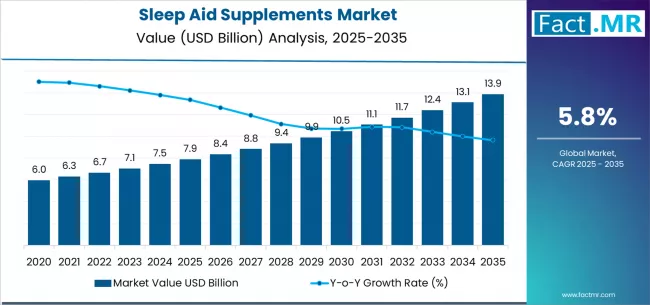
| Sleep Aid Supplements Market Value (2025) | USD 7.9 billion |
|---|---|
| Sleep Aid Supplements Market Forecast Value (2035) | USD 13.4 billion |
| Sleep Aid Supplements Market CAGR | 5.8% |
| Leading Segment by Ingredient (2025) | Melatonin (44.0%) |
| Leading Segment by Form (2025) | Tablets/Capsules (58.0%) |
| Leading Segment by Channel (2025) | Online (47.0%) |
| Key Growth Regions | North America, Europe, and Asia Pacific |
| Top Companies by Market Share | Natrol, NOW Foods, Nature's Bounty |
Sleep Aid Supplements Market Key Takeaways
| Metric | Value |
|---|---|
| Market Value (2025) | USD 7.9 billion |
| Market Forecast Value (2035) | USD 13.4 billion |
| Forecast CAGR (2025-2035) | 5.8% |
Why is the Sleep Aid Supplements Market Growing?
| WELLNESS & HEALTH TRENDS | SLEEP DISORDER AWARENESS | REGULATORY & QUALITY STANDARDS |
|---|---|---|
| Global Sleep Health Recognition | Sleep Disorder Prevalence | Supplement Quality Standards |
| Continuous expansion of sleep health awareness across established and emerging markets driving demand for natural sleep aid solutions. | Modern lifestyle factors contributing to sleep disorders requiring effective supplement interventions and sleep quality improvement. | Regulatory requirements establishing safety benchmarks favoring high-quality natural sleep aid ingredients. |
| Natural Wellness Preference | Stress Management Demands | Safety Assurance Standards |
| Growing focus on natural sleep solutions and holistic wellness creating demand for plant-based and melatonin supplement applications. | Consumers seeking natural stress relief and sleep quality enhancement investing in premium supplement formulations offering consistent efficacy. | Quality standards requiring superior bioavailability properties and resistance to degradation in supplement manufacturing. |
| Premium Sleep Support Positioning | Quality and Efficacy Standards | Clinical Validation Requirements |
| Superior sleep-inducing properties and wellness characteristics making natural sleep aids essential for premium health and wellness applications. | Certified manufacturers with proven track records required for advanced sleep support and therapeutic supplement applications. | Diverse clinical requirements and efficacy standards driving need for scientifically validated sleep aid ingredients. |
Sleep Aid Supplements Market Segmentation
| Category | Segments Covered |
|---|---|
| By Ingredient | Melatonin, Herbal Blends (Valerian, Chamomile), Amino Acids (GABA/5-HTP) |
| By Form | Tablets/Capsules, Gummies/Liquids, Powders |
| By Channel | Online, Retail, Healthcare |
| By Region | North America, Europe, Asia Pacific, Latin America, Middle East & Africa |
Sleep Aid Supplements Market Analysis by Ingredient
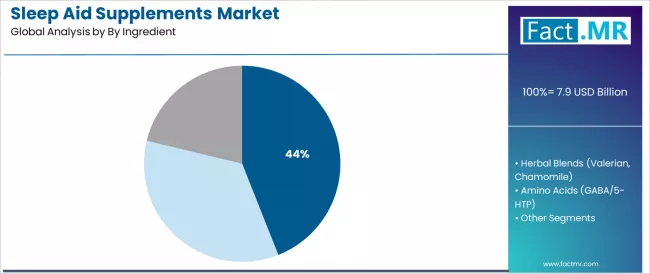
| Segment | 2025 to 2035 Outlook |
|---|---|
| Melatonin | Leader in 2025 with 44.0% market share; likely to maintain leadership through 2035. Clinically proven sleep regulation with established safety profile and broad consumer acceptance. Momentum: steady-to-strong. Watchouts: regulatory restrictions in some markets, timing sensitivity for optimal effectiveness. |
| Herbal Blends (Valerian, Chamomile) | Strong segment with 33.0% market share due to natural positioning and traditional use heritage in sleep support applications. Benefits from clean-label trends and holistic wellness preferences. Momentum: steady growth driven by natural wellness trends and anxiety management applications. |
| Amino Acids (GABA/5-HTP) | Represents 23.0% market share, benefiting from neurotransmitter support mechanisms and growing understanding of sleep biochemistry. Strong in premium formulations and targeted sleep solutions. Momentum: rising in science-backed applications. Watchouts: higher ingredient costs, complex bioavailability requirements. |
Sleep Aid Supplements Market Analysis by Form
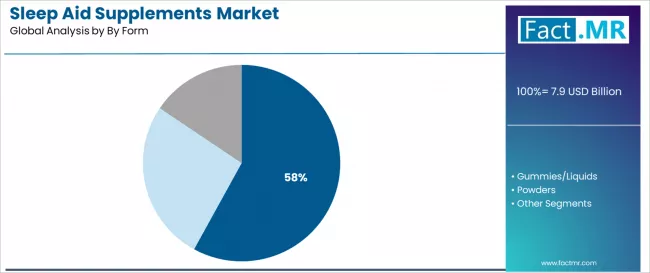
| Segment | 2025 to 2035 Outlook |
|---|---|
| Tablets/Capsules | At 58.0%, largest form segment in 2025 with established consumer preference and precise dosing capabilities. Mature manufacturing processes, standardized quality specifications. Momentum: steady growth driven by convenience and dosage accuracy. Watchouts: competition from innovative delivery formats, consumer preference shifts toward palatability. |
| Gummies/Liquids | Strong segment with 27.0% share driven by consumer preference for palatable and convenient supplement formats. Benefits from improved compliance and faster onset characteristics. Momentum: strong growth through 2030, supported by taste innovation and consumer convenience trends. Watchouts: sugar content concerns, formulation stability challenges in humid environments. |
| Powders | Holds 15.0% share encompassing beverage mixes and customizable dosing applications. Growing focus on personalized nutrition and flexible supplementation driving specialized formulations. Momentum: moderate growth via customization trends and functional beverage development. Watchouts: preparation convenience barriers, taste masking challenges with active ingredients. |
Sleep Aid Supplements Market Analysis by Channel
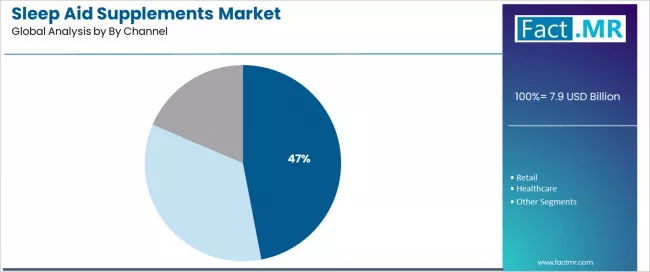
| Segment | 2025 to 2035 Outlook |
|---|---|
| Online | Dominant segment with 47.0% market share due to convenience, privacy, and extensive product selection. Benefits from subscription models and direct-to-consumer relationships. Momentum: steady growth driven by e-commerce expansion and consumer education content. Watchouts: regulatory compliance across jurisdictions, counterfeit product concerns, shipping restrictions on certain ingredients. |
| Retail | Represents 38.0% market share, favored for immediate availability and in-person consultation opportunities. Strong in pharmacy chains and health food stores with knowledgeable staff. Momentum: moderate growth in specialty retail formats despite overall e-commerce migration. Watchouts: shelf space competition, margin pressure from online pricing, inventory management complexity. |
| Healthcare | Holds 15.0% share encompassing medical recommendations and practitioner-dispensed formulations. Growing focus on clinical validation and therapeutic sleep management driving professional channel development. Momentum: selective growth in practitioner-recommended and clinical-grade formulations. Innovation-dependent with longer validation and adoption cycles. |
DRIVERS
| DRIVERS | RESTRAINTS | KEY TRENDS |
|---|---|---|
| Global Sleep Disorder Growth | Regulatory Variations | Advanced Formulation Technologies |
| Continuing expansion of sleep disorder prevalence across established and emerging markets driving demand for effective sleep aid solutions. | Varying international regulations affecting melatonin availability and dosage restrictions across different markets. | Integration of advanced delivery systems, bioavailability enhancement, and sustained-release technologies enabling superior efficacy. |
| Stress-Related Sleep Issues | Side Effect Concerns | Personalized Sleep Solutions |
| Increasing recognition of stress-induced sleep problems and lifestyle factors requiring natural intervention and holistic wellness approaches. | Consumer concerns about dependency potential and next-day drowsiness affecting adoption of certain sleep aid formulations. | Enhanced customization capabilities, sleep tracking integration, and personalized dosing protocols compared to traditional approaches. |
| Premium Wellness Positioning | Ingredient Standardization | Natural and Organic Innovation |
| Growing demand for supplements that support both sleep quality and overall wellness in premium health-focused consumer segments. | Quality standardization challenges and bioactive compound variability affecting consistent efficacy across different supplement brands. | Development of organic certifications and clean-label formulations providing enhanced consumer trust and premium positioning opportunities. |
Analysis of Sleep Aid Supplements Market by Key Countries
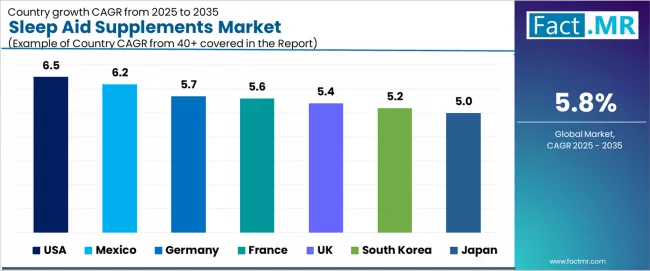
| Country | CAGR (2025-2035) |
|---|---|
| USA | 6.5% |
| Germany | 5.7% |
| France | 5.6% |
| UK | 5.4% |
| South Korea | 5.2% |
| Japan | 5.0% |
| Mexico | 6.2% |
USA Leads Global Market Growth with Wellness Innovation Excellence
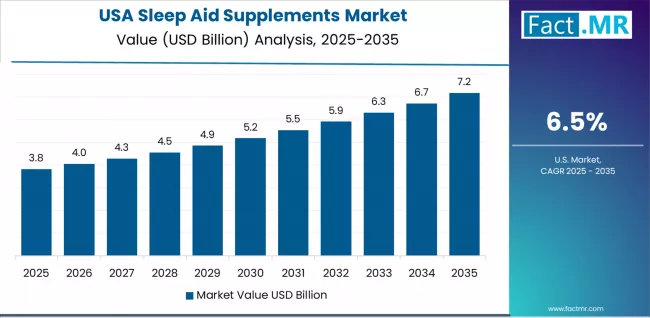
The USA is projected to exhibit strong growth with a market value of USD 4.2 billion by 2035, driven by expanding wellness industry infrastructure and comprehensive sleep health innovation creating substantial opportunities for supplement suppliers across consumer health operations, natural wellness applications, and premium therapeutic sectors. The country's established dietary supplement tradition and expanding sleep disorder awareness are creating significant demand for both conventional and premium-grade natural sleep aids. Major supplement companies and wellness brands including Natrol, NOW Foods, and specialty sleep-focused manufacturers are establishing comprehensive local formulation facilities to support large-scale production operations and meet growing demand for effective sleep solutions.
- Wellness industry modernization programs are supporting widespread adoption of sleep aid supplements across consumer health operations, driving demand for high-quality natural ingredients
- Sleep disorder awareness initiatives and healthcare integration development are creating substantial opportunities for supplement suppliers requiring reliable efficacy and cost-effective natural solutions
- E-commerce growth and direct-to-consumer development are facilitating adoption of specialty sleep supplements throughout major consumer wellness regions
Germany Demonstrates Strong Market Potential with Natural Health Growth
Germany is expanding to reach USD 1.8 billion by 2035, supported by extensive natural health expansion and comprehensive herbal supplement industry development creating steady demand for reliable sleep aid solutions across diverse wellness categories and specialty therapeutic segments. The country's dominant herbal medicine position and expanding stress management capabilities are driving demand for supplement solutions that provide consistent sleep support while supporting cost-effective wellness requirements. Sleep aid processors and wellness suppliers are investing in local quality facilities to support growing manufacturing operations and consumer supplement demand.
- Natural health operations expansion and herbal supplement capability development are creating opportunities for sleep aid solutions across diverse wellness segments requiring reliable performance and competitive production costs
- Stress management modernization and therapeutic advancement are driving investments in supplement supply chains supporting sleep health requirements throughout major wellness regions
- Pharmaceutical integration growth and specialty supplement development programs are enhancing demand for clinical-grade sleep aids throughout German wellness areas
France Maintains Leadership with Wellness Innovation
France is projected to reach USD 1.5 billion by 2035, supported by the country's leadership in wellness innovation and premium health technologies requiring sophisticated supplement systems for stress management and therapeutic sleep applications. French companies are implementing high-quality supplement procurement that supports advanced wellness techniques, operational efficiency, and comprehensive quality protocols. The market is characterized by focus on operational excellence, ingredient sustainability, and compliance with stringent health quality and therapeutic performance standards.
- Wellness innovation industry investments are prioritizing premium supplement technologies that demonstrate superior sleep support and quality while meeting French health and wellness standards
- Stress management leadership programs and operational excellence initiatives are driving adoption of precision-formulated supplement systems that support advanced wellness requirements and sleep optimization
- Research and development programs for health enhancement are facilitating adoption of specialized supplement techniques throughout major wellness innovation centers
UK Expands Market with Natural Wellness Innovation
The United Kingdom is growing to reach USD 1.2 billion by 2035, driven by natural wellness development programs and increasing holistic health innovation creating constant opportunities for supplement suppliers serving both consumer wellness operations and specialty therapeutic contractors. The country's established natural health manufacturing base and expanding sleep awareness are creating demand for supplement solutions that support diverse wellness requirements while maintaining manufacturing efficiency standards. Supplement suppliers and wellness distributors are developing procurement strategies to support operational efficiency and regulatory compliance.
- Natural wellness development programs and holistic health innovation are facilitating adoption of supplement solutions capable of supporting diverse sleep requirements and competitive efficiency standards
- Sleep awareness innovation and wellness manufacturing development programs are enhancing demand for premium-grade supplements that support operational efficiency and therapeutic reliability
- Post-Brexit wellness adaptation and specialty supplement development are creating opportunities for advanced sleep aid technologies across British wellness facilities
South Korea Focuses on K-Wellness Manufacturing Excellence
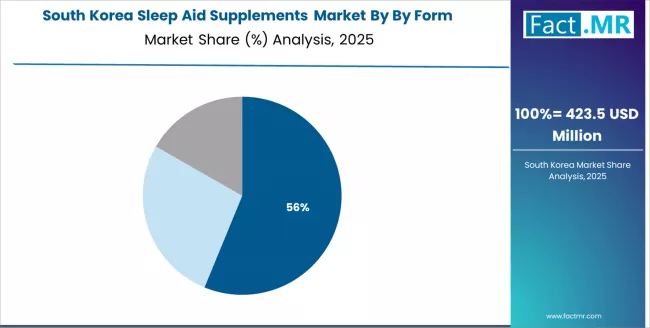
South Korea is projected to reach USD 980 million by 2035, expanding at a CAGR of 5.2%, driven by K-wellness manufacturing excellence and specialty health capabilities supporting advanced stress management and comprehensive wellness applications. The country's established wellness manufacturing tradition and growing natural health market segments are creating demand for high-quality supplement solutions that support operational performance and therapeutic standards. Supplement suppliers and wellness manufacturers are maintaining comprehensive development capabilities to support diverse health manufacturing requirements.
- K-wellness manufacturing and specialty health programs are supporting demand for premium-grade supplements that meet contemporary quality and therapeutic performance standards
- Advanced stress management and natural health manufacturing programs are creating opportunities for specialized supplement solutions that provide comprehensive wellness support
- Wellness export excellence and ingredient quality enhancement programs are facilitating adoption of advanced supplement capabilities throughout major health production regions
Japan Demonstrates Strong Market Potential with Traditional Wellness Integration
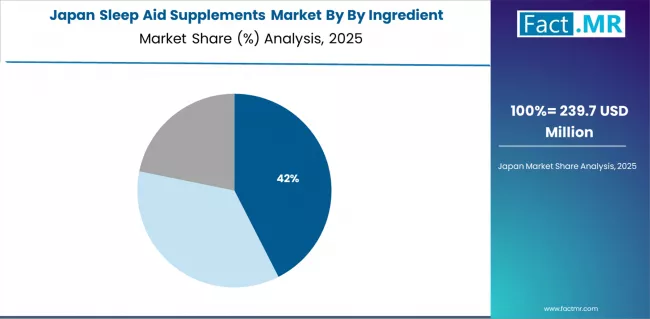
Japan is projected to reach USD 850 million by 2035, expanding at a CAGR of 5.0%, driven by traditional wellness integration and comprehensive herbal supplement capabilities supporting advanced sleep culture and holistic health applications. The country's established pharmaceutical tradition and growing natural wellness market segments are creating demand for high-quality supplement solutions that support cultural wellness practices and therapeutic standards. Supplement suppliers and wellness manufacturers are maintaining comprehensive development capabilities to support diverse traditional health requirements.
- Traditional wellness integration and herbal supplement programs are supporting demand for culturally-aligned supplements that meet contemporary quality and traditional efficacy standards
- Sleep culture enhancement and natural health manufacturing programs are creating opportunities for specialized supplement solutions that provide comprehensive wellness support
- Pharmaceutical quality excellence and ingredient enhancement programs are facilitating adoption of advanced supplement capabilities throughout major health production regions
Mexico Expands Market with Growing Wellness Awareness
Mexico is growing to reach USD 720 million by 2035, expanding at a CAGR of 6.2%, driven by growing wellness awareness development programs and increasing natural health innovation creating constant opportunities for supplement suppliers serving both consumer wellness operations and emerging health consciousness sectors. The country's expanding middle-class healthcare access and growing stress management awareness are creating demand for supplement solutions that support diverse wellness requirements while maintaining affordability standards. Supplement suppliers and wellness distributors are developing market strategies to support accessibility and regulatory compliance.
- Wellness awareness development programs and natural health innovation are facilitating adoption of supplement solutions capable of supporting diverse sleep requirements and competitive accessibility standards
- Stress management awareness and wellness manufacturing development programs are enhancing demand for affordable supplements that support operational efficiency and therapeutic reliability
- Healthcare accessibility expansion and specialty supplement development are creating opportunities for advanced sleep aid technologies across Mexican wellness markets
Europe Market Split by Country
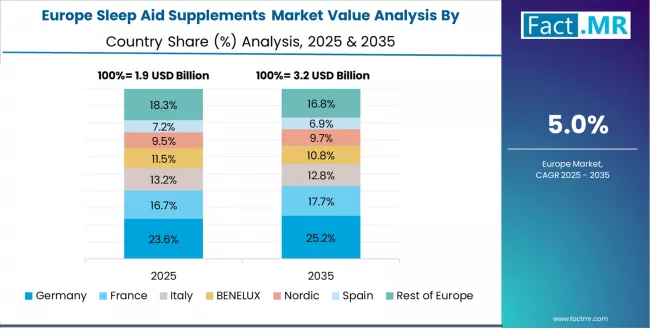
The sleep aid supplements market in Europe is projected to grow from USD 2.1 billion in 2025 to USD 3.6 billion by 2035, registering a CAGR of 5.5% over the forecast period. Germany is expected to maintain its leadership position with a 27.8% market share in 2025, supported by its advanced natural health industry and comprehensive herbal supplement capabilities including major facilities for established wellness companies and pharmaceutical manufacturers.
France follows with a 20.4% share in 2025, projected to reach 20.8% by 2035, driven by comprehensive wellness innovation programs and premium health product development. The United Kingdom holds a 17.9% share in 2025, expected to maintain 17.5% by 2035 despite post-Brexit regulatory adjustments. Italy commands a 16.2% share, while Spain accounts for 10.1% in 2025. The Rest of Europe region is anticipated to gain momentum, expanding its collective share from 7.6% to 8.4% by 2035, attributed to increasing wellness awareness in Nordic countries and emerging Eastern European health manufacturers implementing natural supplement strategies.
Premium Quality Standards Define Japanese Market Dynamics
Japanese sleep aid supplement operations reflect the country's exacting quality standards and sophisticated wellness expectations. Major pharmaceutical and wellness companies including Takeda, Otsuka, and Yakult maintain rigorous supplier qualification processes that often exceed international standards, requiring extensive documentation, efficacy testing, and facility audits that can take 12-18 months to complete. This creates high barriers for new suppliers but ensures consistent quality that supports premium product positioning.
The Japanese market demonstrates unique wellness preferences, with significant demand for traditional herbal formulations tailored to Japanese sleep culture including premium botanical blends, stress management formulations, and holistic wellness solutions. Companies require specific bioactive profiles and therapeutic characteristics that differ from Western applications, driving demand for specialized formulation and quality control capabilities.
Regulatory oversight through the Ministry of Health, Labour and Welfare emphasizes comprehensive safety standards and efficacy requirements that surpass most international benchmarks. The supplement registration system requires detailed clinical documentation, creating advantages for suppliers with transparent research data and comprehensive quality validation.
Supply chain management focuses on relationship-based partnerships rather than purely transactional procurement. Japanese companies typically maintain long-term supplier relationships spanning decades, with annual contract negotiations emphasizing quality consistency and therapeutic reliability over price competition. This stability supports investment in specialized manufacturing equipment tailored to Japanese wellness specifications.
Market Dynamics Drive Innovation in South Korea
South Korean sleep aid supplement operations reflect the country's advanced wellness industry and export-oriented business model. Major health conglomerates including Korea Ginseng Corp, Chong Kun Dang, and wellness-focused companies drive sophisticated ingredient procurement strategies, establishing direct relationships with global suppliers to secure consistent quality and pricing for their health and wellness operations targeting both domestic and international markets.
The Korean market demonstrates particular strength in applying sleep aid supplements to K-wellness applications, with companies developing innovative formulations that integrate traditional Korean herbal medicine with modern sleep science and stress management approaches. This innovation approach creates demand for specific supplement specifications that often exceed standard applications, requiring suppliers to adapt formulation and quality control techniques.
Regulatory frameworks emphasize health product safety and export competitiveness, with Korean Food and Drug Administration standards often exceeding international requirements. This creates barriers for lower-quality suppliers but benefits established manufacturers who can demonstrate advanced efficacy capabilities. The regulatory environment particularly favors suppliers with comprehensive clinical documentation and quality management systems.
Supply chain efficiency remains critical given Korea's position as a wellness export hub. Companies increasingly pursue long-term contracts with suppliers in North America, Europe, and specialized botanical regions to ensure reliable access to high-quality ingredients while managing seasonal availability and foreign exchange risks. Advanced storage and logistics investments support ingredient quality preservation during extended shipping periods.
Competitive Landscape of Sleep Aid Supplements Market
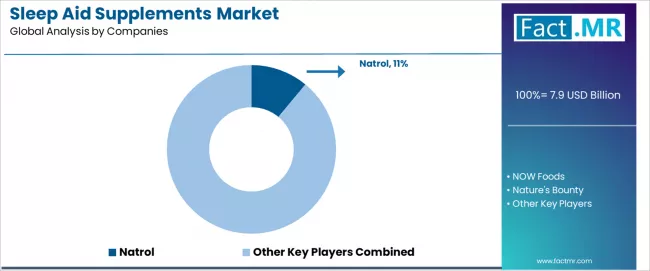
Profit pools are consolidating upstream in scaled ingredient sourcing systems and downstream in value-added specialty formulations for wellness, therapeutic, and lifestyle applications. Value is migrating from basic supplement manufacturing to specification-tight, efficacy-proven supplement solutions where clinical validation, quality assurance, and consistent therapeutic performance command premiums. Several archetypes set the pace: global supplement manufacturers defending share through brand recognition and distribution reliability; specialty wellness companies that manage formulation complexity and consumer education; clinical-grade manufacturers with research IP and healthcare practitioner relationships; and direct-to-consumer innovators pulling volume in personalized sleep solutions and subscription-based wellness programs.
Switching costs, reformulation requirements, clinical validation, regulatory compliance—stabilize market position for incumbents, while ingredient supply shocks (regulatory changes, quality issues, efficacy scrutiny) and wellness trends reopen opportunities for innovative formulations. Consolidation and vertical integration continue; e-commerce procurement dominates consumer channels as healthcare applications remain relationship-dependent. Market dynamics favor suppliers with comprehensive quality capabilities, clinical research programs, and established healthcare professional networks.
The competitive environment presents both opportunities and constraints. Premium efficacy requirements create barriers for basic supplement manufacturers but establish standards that favor clinically validated natural solutions over unproven alternatives. Consumer education increasingly influences purchase decisions as wellness awareness drives demand for transparent and effective formulations.
| Stakeholder Type | Primary Advantage | Repeatable Plays |
|---|---|---|
| Global supplement manufacturers | Scale, brand recognition, distribution reliability | Long-term retail partnerships, consistent quality standards, mass market accessibility |
| Specialty wellness companies | Formulation expertise, consumer education | Premium positioning, targeted marketing, lifestyle integration |
| Clinical-grade manufacturers | Research IP and healthcare ties | Clinical validation, practitioner relationships, therapeutic positioning |
| Direct-to-consumer innovators | Personalization, subscription models | Data-driven customization, consumer engagement, digital marketing excellence |
Key Players in the Sleep Aid Supplements Market
- Natrol
- NOW Foods
- Nature's Bounty
- Nestlé
- Bayer consumer OTC
- Hims & Hers
- Zarbee's
- Olly
- Schiff Nutrition
- Life Extension
Scope of the Report
| Items | Values |
|---|---|
| Quantitative Units | USD 7.9 billion |
| Product | Melatonin, Herbal Blends (Valerian, Chamomile), Amino Acids (GABA/5-HTP) |
| Form | Tablets/Capsules, Gummies/Liquids, Powders |
| Regions Covered | North America, Latin America, Europe, Asia Pacific, Middle East & Africa |
| Country Covered | United States, Germany, France, UK, South Korea, and other 40+ countries |
| Key Companies Profiled | Natrol, NOW Foods, Nature's Bounty, Nestlé, Bayer consumer OTC, Hims & Hers, Zarbee's, Olly, Schiff Nutrition, Life Extension |
| Additional Attributes | Dollar sales by ingredient/form/channel, regional demand (NA, EU, APAC), competitive landscape, wellness industry adoption, clinical validation integration, and advanced formulation innovations driving efficacy enhancement, consumer trust, and therapeutic reliability |
Sleep Aid Supplements Market Segmentation
-
By Ingredient :
- Melatonin
- Herbal Blends (Valerian, Chamomile)
- Amino Acids (GABA/5-HTP)
-
By Form :
- Tablets/Capsules
- Gummies/Liquids
- Powders
-
By Channel :
- Online
- Retail
- Healthcare
-
By Region :
- North America
- Europe
- Asia Pacific
- Latin America
- Middle East & Africa
Table of Content
- Executive Summary
- Global Market Outlook
- Demand to side Trends
- Supply to side Trends
- Technology Roadmap Analysis
- Analysis and Recommendations
- Market Overview
- Market Coverage / Taxonomy
- Market Definition / Scope / Limitations
- Market Background
- Market Dynamics
- Drivers
- Restraints
- Opportunity
- Trends
- Scenario Forecast
- Demand in Optimistic Scenario
- Demand in Likely Scenario
- Demand in Conservative Scenario
- Opportunity Map Analysis
- Product Life Cycle Analysis
- Supply Chain Analysis
- Investment Feasibility Matrix
- Value Chain Analysis
- PESTLE and Porter’s Analysis
- Regulatory Landscape
- Regional Parent Market Outlook
- Production and Consumption Statistics
- Import and Export Statistics
- Market Dynamics
- Global Market Analysis 2020 to 2024 and Forecast, 2025 to 2035
- Historical Market Size Value (USD Million) Analysis, 2020 to 2024
- Current and Future Market Size Value (USD Million) Projections, 2025 to 2035
- Y to o to Y Growth Trend Analysis
- Absolute $ Opportunity Analysis
- Global Market Pricing Analysis 2020 to 2024 and Forecast 2025 to 2035
- Global Market Analysis 2020 to 2024 and Forecast 2025 to 2035, By By Ingredient
- Introduction / Key Findings
- Historical Market Size Value (USD Million) Analysis By By Ingredient , 2020 to 2024
- Current and Future Market Size Value (USD Million) Analysis and Forecast By By Ingredient , 2025 to 2035
- Melatonin
- Herbal Blends (Valerian, Chamomile)
- Amino Acids (GABA/5-HTP)
- Y to o to Y Growth Trend Analysis By By Ingredient , 2020 to 2024
- Absolute $ Opportunity Analysis By By Ingredient , 2025 to 2035
- Global Market Analysis 2020 to 2024 and Forecast 2025 to 2035, By By Form
- Introduction / Key Findings
- Historical Market Size Value (USD Million) Analysis By By Form, 2020 to 2024
- Current and Future Market Size Value (USD Million) Analysis and Forecast By By Form, 2025 to 2035
- Tablets/Capsules
- Gummies/Liquids
- Powders
- Y to o to Y Growth Trend Analysis By By Form, 2020 to 2024
- Absolute $ Opportunity Analysis By By Form, 2025 to 2035
- Global Market Analysis 2020 to 2024 and Forecast 2025 to 2035, By By Channel
- Introduction / Key Findings
- Historical Market Size Value (USD Million) Analysis By By Channel, 2020 to 2024
- Current and Future Market Size Value (USD Million) Analysis and Forecast By By Channel, 2025 to 2035
- Online
- Retail
- Healthcare
- Y to o to Y Growth Trend Analysis By By Channel, 2020 to 2024
- Absolute $ Opportunity Analysis By By Channel, 2025 to 2035
- Global Market Analysis 2020 to 2024 and Forecast 2025 to 2035, By Region
- Introduction
- Historical Market Size Value (USD Million) Analysis By Region, 2020 to 2024
- Current Market Size Value (USD Million) Analysis and Forecast By Region, 2025 to 2035
- North America
- Latin America
- Western Europe
- Eastern Europe
- East Asia
- South Asia and Pacific
- Middle East & Africa
- Market Attractiveness Analysis By Region
- North America Market Analysis 2020 to 2024 and Forecast 2025 to 2035, By Country
- Historical Market Size Value (USD Million) Trend Analysis By Market Taxonomy, 2020 to 2024
- Market Size Value (USD Million) Forecast By Market Taxonomy, 2025 to 2035
- By Country
- USA
- Canada
- Mexico
- By By Ingredient
- By By Form
- By By Channel
- By Country
- Market Attractiveness Analysis
- By Country
- By By Ingredient
- By By Form
- By By Channel
- Key Takeaways
- Latin America Market Analysis 2020 to 2024 and Forecast 2025 to 2035, By Country
- Historical Market Size Value (USD Million) Trend Analysis By Market Taxonomy, 2020 to 2024
- Market Size Value (USD Million) Forecast By Market Taxonomy, 2025 to 2035
- By Country
- Brazil
- Chile
- Rest of Latin America
- By By Ingredient
- By By Form
- By By Channel
- By Country
- Market Attractiveness Analysis
- By Country
- By By Ingredient
- By By Form
- By By Channel
- Key Takeaways
- Western Europe Market Analysis 2020 to 2024 and Forecast 2025 to 2035, By Country
- Historical Market Size Value (USD Million) Trend Analysis By Market Taxonomy, 2020 to 2024
- Market Size Value (USD Million) Forecast By Market Taxonomy, 2025 to 2035
- By Country
- Germany
- UK
- Italy
- Spain
- France
- Nordic
- BENELUX
- Rest of Western Europe
- By By Ingredient
- By By Form
- By By Channel
- By Country
- Market Attractiveness Analysis
- By Country
- By By Ingredient
- By By Form
- By By Channel
- Key Takeaways
- Eastern Europe Market Analysis 2020 to 2024 and Forecast 2025 to 2035, By Country
- Historical Market Size Value (USD Million) Trend Analysis By Market Taxonomy, 2020 to 2024
- Market Size Value (USD Million) Forecast By Market Taxonomy, 2025 to 2035
- By Country
- Russia
- Poland
- Hungary
- Balkan & Baltic
- Rest of Eastern Europe
- By By Ingredient
- By By Form
- By By Channel
- By Country
- Market Attractiveness Analysis
- By Country
- By By Ingredient
- By By Form
- By By Channel
- Key Takeaways
- East Asia Market Analysis 2020 to 2024 and Forecast 2025 to 2035, By Country
- Historical Market Size Value (USD Million) Trend Analysis By Market Taxonomy, 2020 to 2024
- Market Size Value (USD Million) Forecast By Market Taxonomy, 2025 to 2035
- By Country
- China
- Japan
- South Korea
- By By Ingredient
- By By Form
- By By Channel
- By Country
- Market Attractiveness Analysis
- By Country
- By By Ingredient
- By By Form
- By By Channel
- Key Takeaways
- South Asia and Pacific Market Analysis 2020 to 2024 and Forecast 2025 to 2035, By Country
- Historical Market Size Value (USD Million) Trend Analysis By Market Taxonomy, 2020 to 2024
- Market Size Value (USD Million) Forecast By Market Taxonomy, 2025 to 2035
- By Country
- India
- ASEAN
- Australia & New Zealand
- Rest of South Asia and Pacific
- By By Ingredient
- By By Form
- By By Channel
- By Country
- Market Attractiveness Analysis
- By Country
- By By Ingredient
- By By Form
- By By Channel
- Key Takeaways
- Middle East & Africa Market Analysis 2020 to 2024 and Forecast 2025 to 2035, By Country
- Historical Market Size Value (USD Million) Trend Analysis By Market Taxonomy, 2020 to 2024
- Market Size Value (USD Million) Forecast By Market Taxonomy, 2025 to 2035
- By Country
- Kingdom of Saudi Arabia
- Other GCC Countries
- Turkiye
- South Africa
- Other African Union
- Rest of Middle East & Africa
- By By Ingredient
- By By Form
- By By Channel
- By Country
- Market Attractiveness Analysis
- By Country
- By By Ingredient
- By By Form
- By By Channel
- Key Takeaways
- Key Countries Market Analysis
- USA
- Pricing Analysis
- Market Share Analysis, 2024
- By By Ingredient
- By By Form
- By By Channel
- Canada
- Pricing Analysis
- Market Share Analysis, 2024
- By By Ingredient
- By By Form
- By By Channel
- Mexico
- Pricing Analysis
- Market Share Analysis, 2024
- By By Ingredient
- By By Form
- By By Channel
- Brazil
- Pricing Analysis
- Market Share Analysis, 2024
- By By Ingredient
- By By Form
- By By Channel
- Chile
- Pricing Analysis
- Market Share Analysis, 2024
- By By Ingredient
- By By Form
- By By Channel
- Germany
- Pricing Analysis
- Market Share Analysis, 2024
- By By Ingredient
- By By Form
- By By Channel
- UK
- Pricing Analysis
- Market Share Analysis, 2024
- By By Ingredient
- By By Form
- By By Channel
- Italy
- Pricing Analysis
- Market Share Analysis, 2024
- By By Ingredient
- By By Form
- By By Channel
- Spain
- Pricing Analysis
- Market Share Analysis, 2024
- By By Ingredient
- By By Form
- By By Channel
- France
- Pricing Analysis
- Market Share Analysis, 2024
- By By Ingredient
- By By Form
- By By Channel
- India
- Pricing Analysis
- Market Share Analysis, 2024
- By By Ingredient
- By By Form
- By By Channel
- ASEAN
- Pricing Analysis
- Market Share Analysis, 2024
- By By Ingredient
- By By Form
- By By Channel
- Australia & New Zealand
- Pricing Analysis
- Market Share Analysis, 2024
- By By Ingredient
- By By Form
- By By Channel
- China
- Pricing Analysis
- Market Share Analysis, 2024
- By By Ingredient
- By By Form
- By By Channel
- Japan
- Pricing Analysis
- Market Share Analysis, 2024
- By By Ingredient
- By By Form
- By By Channel
- South Korea
- Pricing Analysis
- Market Share Analysis, 2024
- By By Ingredient
- By By Form
- By By Channel
- Russia
- Pricing Analysis
- Market Share Analysis, 2024
- By By Ingredient
- By By Form
- By By Channel
- Poland
- Pricing Analysis
- Market Share Analysis, 2024
- By By Ingredient
- By By Form
- By By Channel
- Hungary
- Pricing Analysis
- Market Share Analysis, 2024
- By By Ingredient
- By By Form
- By By Channel
- Kingdom of Saudi Arabia
- Pricing Analysis
- Market Share Analysis, 2024
- By By Ingredient
- By By Form
- By By Channel
- Turkiye
- Pricing Analysis
- Market Share Analysis, 2024
- By By Ingredient
- By By Form
- By By Channel
- South Africa
- Pricing Analysis
- Market Share Analysis, 2024
- By By Ingredient
- By By Form
- By By Channel
- USA
- Market Structure Analysis
- Competition Dashboard
- Competition Benchmarking
- Market Share Analysis of Top Players
- By Regional
- By By Ingredient
- By By Form
- By By Channel
- Competition Analysis
- Competition Deep Dive
- Natrol
- Overview
- Product Portfolio
- Profitability by Market Segments (Product/Age /Sales Channel/Region)
- Sales Footprint
- Strategy Overview
- Marketing Strategy
- Product Strategy
- Channel Strategy
- NOW Foods
- Nature's Bounty
- Nestlé
- Bayer consumer OTC
- Hims & Hers
- Zarbee's
- Olly
- Schiff Nutrition
- Life Extension
- Natrol
- Competition Deep Dive
- Assumptions & Acronyms Used
- Research Methodology
List Of Table
- Table 1: Global Market Value (USD Million) Forecast by Region, 2020 to 2035
- Table 2: Global Market Value (USD Million) Forecast by By Ingredient , 2020 to 2035
- Table 3: Global Market Value (USD Million) Forecast by By Form, 2020 to 2035
- Table 4: Global Market Value (USD Million) Forecast by By Channel, 2020 to 2035
- Table 5: North America Market Value (USD Million) Forecast by Country, 2020 to 2035
- Table 6: North America Market Value (USD Million) Forecast by By Ingredient , 2020 to 2035
- Table 7: North America Market Value (USD Million) Forecast by By Form, 2020 to 2035
- Table 8: North America Market Value (USD Million) Forecast by By Channel, 2020 to 2035
- Table 9: Latin America Market Value (USD Million) Forecast by Country, 2020 to 2035
- Table 10: Latin America Market Value (USD Million) Forecast by By Ingredient , 2020 to 2035
- Table 11: Latin America Market Value (USD Million) Forecast by By Form, 2020 to 2035
- Table 12: Latin America Market Value (USD Million) Forecast by By Channel, 2020 to 2035
- Table 13: Western Europe Market Value (USD Million) Forecast by Country, 2020 to 2035
- Table 14: Western Europe Market Value (USD Million) Forecast by By Ingredient , 2020 to 2035
- Table 15: Western Europe Market Value (USD Million) Forecast by By Form, 2020 to 2035
- Table 16: Western Europe Market Value (USD Million) Forecast by By Channel, 2020 to 2035
- Table 17: Eastern Europe Market Value (USD Million) Forecast by Country, 2020 to 2035
- Table 18: Eastern Europe Market Value (USD Million) Forecast by By Ingredient , 2020 to 2035
- Table 19: Eastern Europe Market Value (USD Million) Forecast by By Form, 2020 to 2035
- Table 20: Eastern Europe Market Value (USD Million) Forecast by By Channel, 2020 to 2035
- Table 21: East Asia Market Value (USD Million) Forecast by Country, 2020 to 2035
- Table 22: East Asia Market Value (USD Million) Forecast by By Ingredient , 2020 to 2035
- Table 23: East Asia Market Value (USD Million) Forecast by By Form, 2020 to 2035
- Table 24: East Asia Market Value (USD Million) Forecast by By Channel, 2020 to 2035
- Table 25: South Asia and Pacific Market Value (USD Million) Forecast by Country, 2020 to 2035
- Table 26: South Asia and Pacific Market Value (USD Million) Forecast by By Ingredient , 2020 to 2035
- Table 27: South Asia and Pacific Market Value (USD Million) Forecast by By Form, 2020 to 2035
- Table 28: South Asia and Pacific Market Value (USD Million) Forecast by By Channel, 2020 to 2035
- Table 29: Middle East & Africa Market Value (USD Million) Forecast by Country, 2020 to 2035
- Table 30: Middle East & Africa Market Value (USD Million) Forecast by By Ingredient , 2020 to 2035
- Table 31: Middle East & Africa Market Value (USD Million) Forecast by By Form, 2020 to 2035
- Table 32: Middle East & Africa Market Value (USD Million) Forecast by By Channel, 2020 to 2035
List Of Figures
- Figure 1: Global Market Pricing Analysis
- Figure 2: Global Market Value (USD Million) Forecast 2020-2035
- Figure 3: Global Market Value Share and BPS Analysis by By Ingredient , 2025 and 2035
- Figure 4: Global Market Y to o to Y Growth Comparison by By Ingredient , 2025-2035
- Figure 5: Global Market Attractiveness Analysis by By Ingredient
- Figure 6: Global Market Value Share and BPS Analysis by By Form, 2025 and 2035
- Figure 7: Global Market Y to o to Y Growth Comparison by By Form, 2025-2035
- Figure 8: Global Market Attractiveness Analysis by By Form
- Figure 9: Global Market Value Share and BPS Analysis by By Channel, 2025 and 2035
- Figure 10: Global Market Y to o to Y Growth Comparison by By Channel, 2025-2035
- Figure 11: Global Market Attractiveness Analysis by By Channel
- Figure 12: Global Market Value (USD Million) Share and BPS Analysis by Region, 2025 and 2035
- Figure 13: Global Market Y to o to Y Growth Comparison by Region, 2025-2035
- Figure 14: Global Market Attractiveness Analysis by Region
- Figure 15: North America Market Incremental Dollar Opportunity, 2025-2035
- Figure 16: Latin America Market Incremental Dollar Opportunity, 2025-2035
- Figure 17: Western Europe Market Incremental Dollar Opportunity, 2025-2035
- Figure 18: Eastern Europe Market Incremental Dollar Opportunity, 2025-2035
- Figure 19: East Asia Market Incremental Dollar Opportunity, 2025-2035
- Figure 20: South Asia and Pacific Market Incremental Dollar Opportunity, 2025-2035
- Figure 21: Middle East & Africa Market Incremental Dollar Opportunity, 2025-2035
- Figure 22: North America Market Value Share and BPS Analysis by Country, 2025 and 2035
- Figure 23: North America Market Value Share and BPS Analysis by By Ingredient , 2025 and 2035
- Figure 24: North America Market Y to o to Y Growth Comparison by By Ingredient , 2025-2035
- Figure 25: North America Market Attractiveness Analysis by By Ingredient
- Figure 26: North America Market Value Share and BPS Analysis by By Form, 2025 and 2035
- Figure 27: North America Market Y to o to Y Growth Comparison by By Form, 2025-2035
- Figure 28: North America Market Attractiveness Analysis by By Form
- Figure 29: North America Market Value Share and BPS Analysis by By Channel, 2025 and 2035
- Figure 30: North America Market Y to o to Y Growth Comparison by By Channel, 2025-2035
- Figure 31: North America Market Attractiveness Analysis by By Channel
- Figure 32: Latin America Market Value Share and BPS Analysis by Country, 2025 and 2035
- Figure 33: Latin America Market Value Share and BPS Analysis by By Ingredient , 2025 and 2035
- Figure 34: Latin America Market Y to o to Y Growth Comparison by By Ingredient , 2025-2035
- Figure 35: Latin America Market Attractiveness Analysis by By Ingredient
- Figure 36: Latin America Market Value Share and BPS Analysis by By Form, 2025 and 2035
- Figure 37: Latin America Market Y to o to Y Growth Comparison by By Form, 2025-2035
- Figure 38: Latin America Market Attractiveness Analysis by By Form
- Figure 39: Latin America Market Value Share and BPS Analysis by By Channel, 2025 and 2035
- Figure 40: Latin America Market Y to o to Y Growth Comparison by By Channel, 2025-2035
- Figure 41: Latin America Market Attractiveness Analysis by By Channel
- Figure 42: Western Europe Market Value Share and BPS Analysis by Country, 2025 and 2035
- Figure 43: Western Europe Market Value Share and BPS Analysis by By Ingredient , 2025 and 2035
- Figure 44: Western Europe Market Y to o to Y Growth Comparison by By Ingredient , 2025-2035
- Figure 45: Western Europe Market Attractiveness Analysis by By Ingredient
- Figure 46: Western Europe Market Value Share and BPS Analysis by By Form, 2025 and 2035
- Figure 47: Western Europe Market Y to o to Y Growth Comparison by By Form, 2025-2035
- Figure 48: Western Europe Market Attractiveness Analysis by By Form
- Figure 49: Western Europe Market Value Share and BPS Analysis by By Channel, 2025 and 2035
- Figure 50: Western Europe Market Y to o to Y Growth Comparison by By Channel, 2025-2035
- Figure 51: Western Europe Market Attractiveness Analysis by By Channel
- Figure 52: Eastern Europe Market Value Share and BPS Analysis by Country, 2025 and 2035
- Figure 53: Eastern Europe Market Value Share and BPS Analysis by By Ingredient , 2025 and 2035
- Figure 54: Eastern Europe Market Y to o to Y Growth Comparison by By Ingredient , 2025-2035
- Figure 55: Eastern Europe Market Attractiveness Analysis by By Ingredient
- Figure 56: Eastern Europe Market Value Share and BPS Analysis by By Form, 2025 and 2035
- Figure 57: Eastern Europe Market Y to o to Y Growth Comparison by By Form, 2025-2035
- Figure 58: Eastern Europe Market Attractiveness Analysis by By Form
- Figure 59: Eastern Europe Market Value Share and BPS Analysis by By Channel, 2025 and 2035
- Figure 60: Eastern Europe Market Y to o to Y Growth Comparison by By Channel, 2025-2035
- Figure 61: Eastern Europe Market Attractiveness Analysis by By Channel
- Figure 62: East Asia Market Value Share and BPS Analysis by Country, 2025 and 2035
- Figure 63: East Asia Market Value Share and BPS Analysis by By Ingredient , 2025 and 2035
- Figure 64: East Asia Market Y to o to Y Growth Comparison by By Ingredient , 2025-2035
- Figure 65: East Asia Market Attractiveness Analysis by By Ingredient
- Figure 66: East Asia Market Value Share and BPS Analysis by By Form, 2025 and 2035
- Figure 67: East Asia Market Y to o to Y Growth Comparison by By Form, 2025-2035
- Figure 68: East Asia Market Attractiveness Analysis by By Form
- Figure 69: East Asia Market Value Share and BPS Analysis by By Channel, 2025 and 2035
- Figure 70: East Asia Market Y to o to Y Growth Comparison by By Channel, 2025-2035
- Figure 71: East Asia Market Attractiveness Analysis by By Channel
- Figure 72: South Asia and Pacific Market Value Share and BPS Analysis by Country, 2025 and 2035
- Figure 73: South Asia and Pacific Market Value Share and BPS Analysis by By Ingredient , 2025 and 2035
- Figure 74: South Asia and Pacific Market Y to o to Y Growth Comparison by By Ingredient , 2025-2035
- Figure 75: South Asia and Pacific Market Attractiveness Analysis by By Ingredient
- Figure 76: South Asia and Pacific Market Value Share and BPS Analysis by By Form, 2025 and 2035
- Figure 77: South Asia and Pacific Market Y to o to Y Growth Comparison by By Form, 2025-2035
- Figure 78: South Asia and Pacific Market Attractiveness Analysis by By Form
- Figure 79: South Asia and Pacific Market Value Share and BPS Analysis by By Channel, 2025 and 2035
- Figure 80: South Asia and Pacific Market Y to o to Y Growth Comparison by By Channel, 2025-2035
- Figure 81: South Asia and Pacific Market Attractiveness Analysis by By Channel
- Figure 82: Middle East & Africa Market Value Share and BPS Analysis by Country, 2025 and 2035
- Figure 83: Middle East & Africa Market Value Share and BPS Analysis by By Ingredient , 2025 and 2035
- Figure 84: Middle East & Africa Market Y to o to Y Growth Comparison by By Ingredient , 2025-2035
- Figure 85: Middle East & Africa Market Attractiveness Analysis by By Ingredient
- Figure 86: Middle East & Africa Market Value Share and BPS Analysis by By Form, 2025 and 2035
- Figure 87: Middle East & Africa Market Y to o to Y Growth Comparison by By Form, 2025-2035
- Figure 88: Middle East & Africa Market Attractiveness Analysis by By Form
- Figure 89: Middle East & Africa Market Value Share and BPS Analysis by By Channel, 2025 and 2035
- Figure 90: Middle East & Africa Market Y to o to Y Growth Comparison by By Channel, 2025-2035
- Figure 91: Middle East & Africa Market Attractiveness Analysis by By Channel
- Figure 92: Global Market - Tier Structure Analysis
- Figure 93: Global Market - Company Share Analysis
- FAQs -
How big is the sleep aid supplements market in 2025?
The global sleep aid supplements market is estimated to be valued at USD 7.9 billion in 2025.
What will be the size of sleep aid supplements market in 2035?
The market size for the sleep aid supplements market is projected to reach USD 13.9 billion by 2035.
How much will be the sleep aid supplements market growth between 2025 and 2035?
The sleep aid supplements market is expected to grow at a 5.8% CAGR between 2025 and 2035.
What are the key product types in the sleep aid supplements market?
The key product types in sleep aid supplements market are melatonin, herbal blends (valerian, chamomile) and amino acids (gaba/5-htp).
Which by form segment to contribute significant share in the sleep aid supplements market in 2025?
In terms of by form, tablets/capsules segment to command 58.0% share in the sleep aid supplements market in 2025.